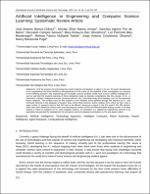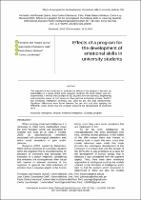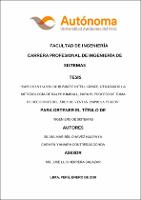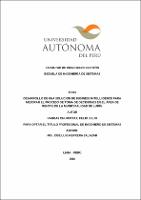| dc.contributor.author | Manco-Chávez, José Antonio | |
| dc.contributor.author | Manco Arroyo, Nicolas Silver | |
| dc.contributor.author | Sánchez Aguirre, Flor de María | |
| dc.contributor.author | Campos Saravia, Reynaldo | |
| dc.contributor.author | Diaz Hinostroza, Mary Rosaura | |
| dc.contributor.author | Blas Montenegro, Luz Petronila | |
| dc.contributor.author | Muñante Toledo, Melissa Fatima | |
| dc.contributor.author | Crisóstomo Olivares, Jorge Antonio | |
| dc.contributor.author | Barazorda Puga, Nancy | |
| dc.date.accessioned | 2023-12-20T15:26:37Z | |
| dc.date.available | 2023-12-20T15:26:37Z | |
| dc.date.issued | 2023 | |
| dc.identifier.uri | https://hdl.handle.net/20.500.13067/2876 | |
| dc.description.abstract | Until the present, the technology has made students and teachers to object in its use, the quick development of it in engineering has been possible by the appearance of the covid-19, the objective of this investigation is to respond to the following question: why engineering and computer science students would have to learn artificial intelligence? It can be said that the students learning of these disciplines study or develop competences like the creation of: A.I. in mechanics, robotics, biological sciences, physical sciences, etc., from where they could develop, such as the advanced neural networks. The method used for this research is the PRISMA which allowed through the keyword of A.I. and Computer Science in the database of Scopus, Wos, World Wide Science, Scielo, Dialnet, from where we then have a large number of research articles that will have to be filtered, having as a result in the first search 321 952 articles, which were then filtered at various times until reaching the number of 320 429 filtered articles leaving us with 37 of them related or linked to research on A.I. and computer science. In conclusion, A.I. applied by engineering schools of all specialties has granted the development for companies and technological contributions to the new digital culture. | es_PE |
| dc.format | application/pdf | es_PE |
| dc.language.iso | eng | es_PE |
| dc.publisher | International Journal of Membrane Science and Technology | es_PE |
| dc.rights | info:eu-repo/semantics/openAccess | es_PE |
| dc.rights.uri | https://creativecommons.org/licenses/by/4.0/ | es_PE |
| dc.subject | Artificial intelligence | es_PE |
| dc.subject | Technology Approach | es_PE |
| dc.subject | Intelligent Computer | es_PE |
| dc.subject | Robot Automata | es_PE |
| dc.subject | Neural Intelligence | es_PE |
| dc.subject | Agent Research | es_PE |
| dc.subject | Computational Intelligence | es_PE |
| dc.title | Artificial Intelligence in Engineering and Computer Science Learning: Systematic Review Article | es_PE |
| dc.type | info:eu-repo/semantics/article | es_PE |
| dc.identifier.journal | International Journal of Membrane Science and Technology | es_PE |
| dc.identifier.doi | https://doi.org/10.15379/ijmst.v10i3.1514 | |
| dc.subject.ocde | https://purl.org/pe-repo/ocde/ford#2.02.04 | es_PE |
| dc.relation.url | https://cosmosscholars.com/phms/index.php/ijmst/article/view/1514 | es_PE |
| dc.source.volume | 10 | es_PE |
| dc.source.issue | 3 | es_PE |
| dc.source.beginpage | 221 | es_PE |
| dc.source.endpage | 233 | es_PE |





